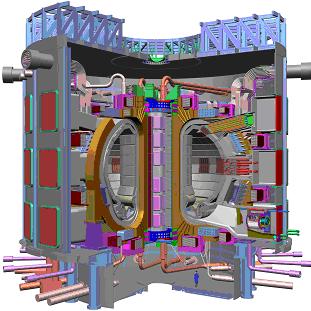l World Development in Fusion Power
Ø Progress
The research into harnessing fusion energy for power generation began in the late fifties. The scientists at the time thought that fusion power would be developed within some tens of years. However, the highly complex and specialized challenges mean that continuing dedicated endeavors are required to develop this potentially attractive and very long term energy source. It will take several further decades before fusion energy is ready to be used as a source of electricity.
During the last fifty years, the world fusion research effort has established a well funded physics and technology basis and demonstrated scientific feasibility. At this stage, magnetic confinement (particularly the tokamak concept) appears to be the most obvious path towards energy production from nuclear fusion. Large successful projects are conducted in many of the industrialized countries such as JET (EU), TFTR and DIII-D (USA) and JT60-U (Japan). High fusion performances reaching 16 MW of peak power and 21 MJ of energy and Q close to one have been achieved.
These are now followed by an even larger international experiment, ITER.
Research on other magnetic confinement schemes () has also produced promising results, though not as close to the fusion conditions as the tokanak scheme. These alternate schemes have the potential of a smaller fusion reactor.
The programmatic goal of the international endeavour, ITER, is "to demonstrate the scientific and technological feasibility of fusion power for peaceful purposes". ITER will enable the fusion community to study plasmas in conditions similar to those expected in an electricity-generating fusion power plant.
ITER should produce 500 MW of fusion power with an energy amplification factor of at least 10. It will aim at demonstrating and testing a number of key technologies and processes essential for future fusion power plants, including superconducting magnets, and remote handling. It will also be used to test components for a future reactor, including prototypes of tritium breeding blankets.
The participants currently include the European Union, Japan, the People´s Republic of China, India, the Republic of Korea, the Russian Federation and the USA. Europe will contribute almost half of the costs of its construction, while the other six members will contribute equally to the rest.
The selection of a location for ITER took a long time and on June 28, 2005 it was officially announced that ITER will be built at the Cadarache site in the south of France. The ITER organization, which will administer the construction and operation of the machine, was formally created on November 21. According to the planned schedule, the first plasma is expected in 2018 and this will be followed by an exploitation phase lasting about 20 years.

Source: http://www.iter.org/a/pictures_html/iter_man_bottom-large.jpg